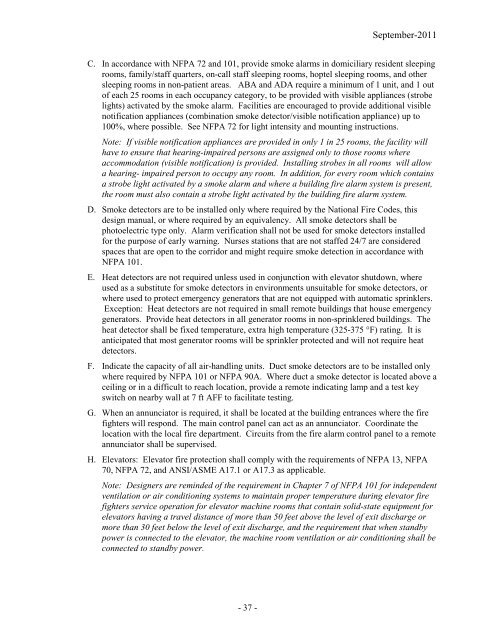Fire Protection Design Manual - Office of Construction and Facilities ...
Fire Protection Design Manual - Office of Construction and Facilities ...
Fire Protection Design Manual - Office of Construction and Facilities ...
You also want an ePaper? Increase the reach of your titles
YUMPU automatically turns print PDFs into web optimized ePapers that Google loves.
September-2011<br />
C. In accordance with NFPA 72 <strong>and</strong> 101, provide smoke alarms in domiciliary resident sleeping<br />
rooms, family/staff quarters, on-call staff sleeping rooms, hoptel sleeping rooms, <strong>and</strong> other<br />
sleeping rooms in non-patient areas. ABA <strong>and</strong> ADA require a minimum <strong>of</strong> 1 unit, <strong>and</strong> 1 out<br />
<strong>of</strong> each 25 rooms in each occupancy category, to be provided with visible appliances (strobe<br />
lights) activated by the smoke alarm. <strong>Facilities</strong> are encouraged to provide additional visible<br />
notification appliances (combination smoke detector/visible notification appliance) up to<br />
100%, where possible. See NFPA 72 for light intensity <strong>and</strong> mounting instructions.<br />
Note: If visible notification appliances are provided in only 1 in 25 rooms, the facility will<br />
have to ensure that hearing-impaired persons are assigned only to those rooms where<br />
accommodation (visible notification) is provided. Installing strobes in all rooms will allow<br />
a hearing- impaired person to occupy any room. In addition, for every room which contains<br />
a strobe light activated by a smoke alarm <strong>and</strong> where a building fire alarm system is present,<br />
the room must also contain a strobe light activated by the building fire alarm system.<br />
D. Smoke detectors are to be installed only where required by the National <strong>Fire</strong> Codes, this<br />
design manual, or where required by an equivalency. All smoke detectors shall be<br />
photoelectric type only. Alarm verification shall not be used for smoke detectors installed<br />
for the purpose <strong>of</strong> early warning. Nurses stations that are not staffed 24/7 are considered<br />
spaces that are open to the corridor <strong>and</strong> might require smoke detection in accordance with<br />
NFPA 101.<br />
E. Heat detectors are not required unless used in conjunction with elevator shutdown, where<br />
used as a substitute for smoke detectors in environments unsuitable for smoke detectors, or<br />
where used to protect emergency generators that are not equipped with automatic sprinklers.<br />
Exception: Heat detectors are not required in small remote buildings that house emergency<br />
generators. Provide heat detectors in all generator rooms in non-sprinklered buildings. The<br />
heat detector shall be fixed temperature, extra high temperature (325-375 °F) rating. It is<br />
anticipated that most generator rooms will be sprinkler protected <strong>and</strong> will not require heat<br />
detectors.<br />
F. Indicate the capacity <strong>of</strong> all air-h<strong>and</strong>ling units. Duct smoke detectors are to be installed only<br />
where required by NFPA 101 or NFPA 90A. Where duct a smoke detector is located above a<br />
ceiling or in a difficult to reach location, provide a remote indicating lamp <strong>and</strong> a test key<br />
switch on nearby wall at 7 ft AFF to facilitate testing.<br />
G. When an annunciator is required, it shall be located at the building entrances where the fire<br />
fighters will respond. The main control panel can act as an annunciator. Coordinate the<br />
location with the local fire department. Circuits from the fire alarm control panel to a remote<br />
annunciator shall be supervised.<br />
H. Elevators: Elevator fire protection shall comply with the requirements <strong>of</strong> NFPA 13, NFPA<br />
70, NFPA 72, <strong>and</strong> ANSI/ASME A17.1 or A17.3 as applicable.<br />
Note: <strong>Design</strong>ers are reminded <strong>of</strong> the requirement in Chapter 7 <strong>of</strong> NFPA 101 for independent<br />
ventilation or air conditioning systems to maintain proper temperature during elevator fire<br />
fighters service operation for elevator machine rooms that contain solid-state equipment for<br />
elevators having a travel distance <strong>of</strong> more than 50 feet above the level <strong>of</strong> exit discharge or<br />
more than 30 feet below the level <strong>of</strong> exit discharge, <strong>and</strong> the requirement that when st<strong>and</strong>by<br />
power is connected to the elevator, the machine room ventilation or air conditioning shall be<br />
connected to st<strong>and</strong>by power.<br />
- 37

















